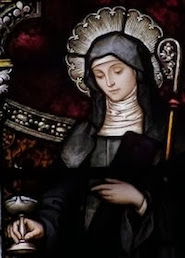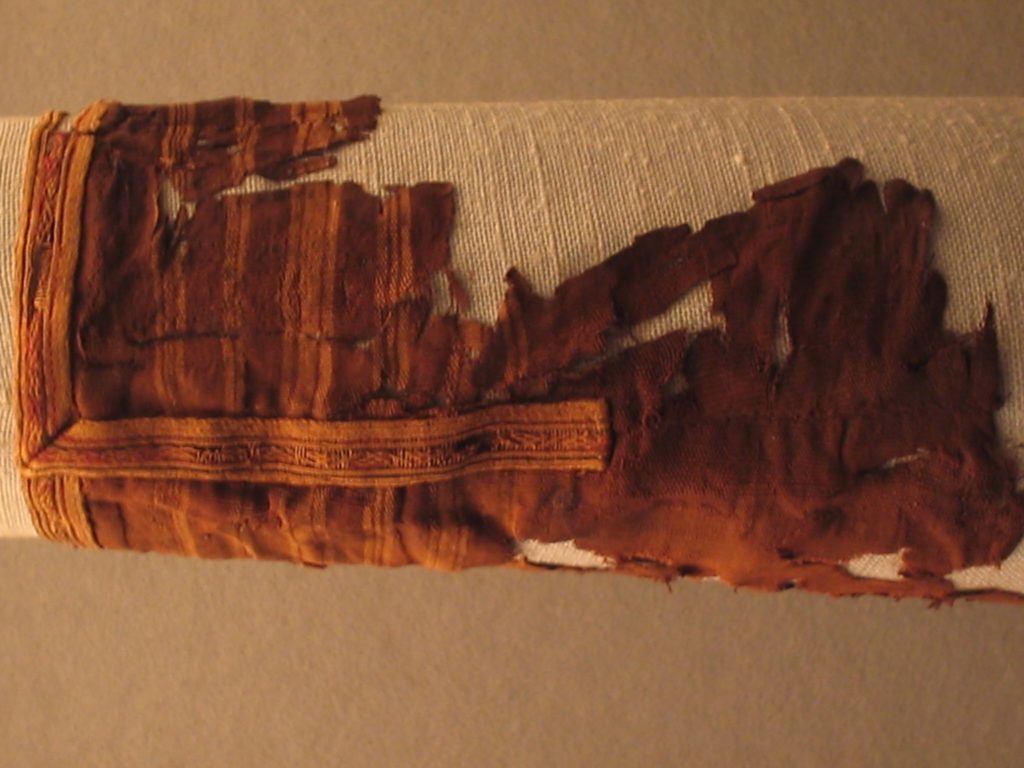Edit! Updated pattern!! After looking at the extant piece and my pattern, I decided that the little blue <> on the sides didn’t belong, so I adjusted it and came up with this!

As the weather cools in the northern hemisphere (and life begins anew in the southern lands) we are minded of the upcoming holidays and thinking ahead for gift ideas for those we love. If you have a Medieval enthusiast on your list, I may have an idea for you! Have you been shopping for reliquaries and coming up empty handed? Vendors all out of slivers of the one true cross? Finger bones of Saints on back order? Well, never fear, fellow weavers—you can create your own relics–the sleeve of St. Bertille!

Born in the early years of the 7th century, Bertille was born to a prominant family in Soissons, France, about 60 miles/100 km northeast of Paris. As a child, she spent her time in prayer and doing “serious duties”, not wanting to spend time doing frivolous things, and as she grew up, she found the world to be tempestuous and despised it. She found comfort in prayer and conversations with God. About the year 630, shortly after it opened, her parents brought her to the Jouarre Abbey in the city of Brie, about 20 mi/30 km SE of Paris. We don’t know how old she was when she arrived, but I would guess between 15 and 20 years.
She was educated by the Abbess Thelchildis and was known for her humility and self-denial. She was committed to aiding the sick and caring for the children being educated at the monastery. When Chelles Abbey was founded, with tremendous support from Queen Bathilde in 646, Bertille was chosen to be its first Abbess. 20 years later, that Queen retired from Royal service, as her son took the throne, and moved to Chelles Abbey, where she lived until her death in 680. The Abbess died 12 years later, in 692. Both were buried at the Abbey and about 200 years later, both had been canonised as saints. Her feast day is November 5th.

Among the textiles, at least three tablet woven pieces were found there—although, their garments were moved in the late 9th century, and displayed as saint relics for passing Pilgrims, then later moved again during the French Revolution to spare them from destruction, so we’re not really sure which woven piece belonged to which woman. Despite the rough handling, the fragments held up remarkably well, and so much detail can be seen on them. The pattern I’m going to share with you today is a bit of tablet weaving on what is presumed to be the Abbess’s sleeve. The extant piece is 9 mm wide, made from silk in red, yellow and dark brown. 2/3 of that width is border cards, so this center design is a very fine 3 mm wide.

Kingdom of Caid, created in 1978, comprises the regions of Southern CA, Southern Nevada (including Las Vegas) and Hawaii. Sounds like a party! Their colors are blue and white, but looking at their banner, it also has yellow in the laurel wreath and crown, so I’m adding a third color because this pattern lends itself well to using three colors…so let’s do that! Grab your looms and let’s get to work!



Love your videos ! I am just starting out and the amount of cards is a bit overwhelming what is the least amount of cards one can use to weave a simple band ?
You can do as few as you like, but perhaps just a very simple pattern will be best. My next video will be a SUPER EASY pattern. I hope you tune in and feel comfortable giving it a try.